|
|
|||
|
(Back to Preceding Week; on to Next Week) |
|
2009 SIGNS OF SPRING (Part 2) During winter signs of nature are often quite subtle. The woods are still alive, but activity--especially within the plant world--slows almost to a stop. Once spring arrives, however, the natural panorama unfolds so suddenly one almost gets whiplash shifting attention from one organism to the next. Such was the case again this week around Hilton Pond, where we were delighted to find all sorts of spring's things to photograph and share.
All text & photos © Hilton Pond Center The property that is now Hilton Pond Center was heavily farmed for perhaps a hundred years such that a century's worth of plowing and grazing pretty much eliminated native plants and their seeds from the soil. A few wildflowers have made their way back during the 28 years we've been in residence, but we also enhanced the floral complement when folks donated specimens from their own gardens. A few years ago someone gave us a soil-filled two-gallon pot with no label on it so we were surprised this spring to see trios of pale, green, mottled leaves (above) emerging from within. As the leaves grew during the past few weeks we figured what we had--especially after the emergence of the purple-brown flowers--wasTrillium cuneatum, better known as Little Sweet Betsy.
All text & photos © Hilton Pond Center This native Southeastern wildflower has a variety of other epithets--Large Toadshade, Purple Toadshade, Bloody Butcher, and Whip-poor-will Flower--nicknames whose origins are puzzling and undoubtedly lost in time. As with all trilliums, the plant's parts are in threes: Three leaves, three sepals, and--hidden within the three petals--three stamens and a pistil. Now that we know the contents of the plastic pot, we'll be moving Little Sweet Betsy to a shady spot beneath one of our Flowering Dogwoods and planting it in less-acidic soil likely to meet its needs--all in the hope it will take hold and continue to blossom in future Aprils.
All text & photos © Hilton Pond Center Not every flower that shows up in spring at Hilton Pond Center is wild. Take, for example, the purple-pink blossom above that recently volunteered its presence near an old chicken house on the property. We somehow missed its bloom last spring but recognized the mid-summer seedpod (below right) that resulted. It could only be Silver Dollar plant, Lunaria annua,
All text & photos © Hilton Pond Center Although its image above is rather large, the specimen in the photo is actually our smallest tailless amphibian: The Northern Cricket Frog, Acris crepitans. This diminutive species, which can be as small as a half-inch long when fully grown--about the size of a thumbnail!--is also one of our most common frogs at Hilton Pond Center. Cricket frogs are in the Tree Frog Family (Hylidae) but are not arboreal, preferring to inhabit open edges of marshes and ponds. They're warty and well-camouflaged--we only saw this specimen because it jumped during our approach--and come in a variety of shades from green to tan to brown. The Southern Cricket Frog, A. gryllus, also occurs in the Carolinas but is relegated essentially to the Coastal Plain, while A. crepitans is found primarily in the Piedmont and at lower elevations in the Mountain Province. One definitive characteristic of all cricket frogs is a stripe that often forms a "Y" in the middle of the frog's back. In our specimen above the mark is rust-colored. Both our cricket frog species have a non-melodic mating call resembling two small pebbles clicking together--cricket-like.
All text & photos © Hilton Pond Center A sure sign of spring at Hilton Pond Center is numerous tent-like webs that appear overnight and quickly increase in size among the branches of our Wild Cherry trees. Each of these webs is created by a sibling colony of Eastern Tent Caterpillars, Malacosoma americanum (above), whose voracious appetite for tender green leaves often leads to complete defoliation of a host tree. As its scientific name indicates, the Eastern Tent Caterpillar is a native species. It has co-evolved with Wild Cherries and would do poorly if the larva killed its host; the caterpillars fortunately pupate and emerge as adult moths without a taste for leaves--giving the cherry tree a chance to rebound with a whole new set of foliage. Eastern Tent Caterpillars are extremely hairy and thus have few predators other than Blue Jays, Northern Mockingbirds, and the occasional Yellow-billed Cuckoo that comes back early in migration. It's interesting the lateral blue spots visible on the caterpillar above are structural colors created not by pigment but from light scattered by microtubules in the larva's cuticle.
All text & photos © Hilton Pond Center Even though they don't nest in the Carolina Piedmont, our winter resident White-throated Sparrows (above) put on spring attire in April that will serve them well on their breeding grounds across Canada and in the extreme northern U.S. The individual pictured is pristine, with immaculate white throat and head-stripes and yellow lores that practically glow. Curiously, plumage brightness is NOT an indicator of age or sex in this species; in fact, there are two color varieties among white-throats. The one above is a classic example of the "bright morph," but there is also a "dull morph" that will never acquire such brilliant feathers. Even more curious, field studies reveal male White-throated Sparrows of either morph prefer bright-morph females, while both female morphs appear to like dull-plumaged males.
All text & photos © Hilton Pond Center Another bird species that undergoes startling change between winter color and its breeding plumage is the American Goldfinch. Super-showy males (below right) exchange olive-green body feathers for a canary yellow that contrasts brilliantly with their always-black wings and tails and new black crowns.
All text & photos © Hilton Pond Center Goldfinches may bide their time to breed, but local Eastern Phoebes waste no time in spring. The female above is sitting on five eggs laid during a very cold week in early April this year, and she's not inclined to leave the nest she constructed atop a column on the front porch of the Hilton Pond farmhouse. We suspect this same bird that occupied this location last year, only because it took her just two days to build the nest out of mosses, oak flowers, and a few unidentified mammal hairs. Besides, despite our frequent comings and goings this bird seems unperturbed and likely will be feeding nestlings by the third week in April. Caterpillars and frogs, colorful flowers and songbirds--all are present as the wonders of Spring 2009 continue to unfold at this week at Hilton Pond. All text & photos © Hilton Pond Center
Comments or questions about this week's installment?
Thanks to the following fine folks for recent gifts in support of Hilton Pond Center for Piedmont Natural History and/or Operation RubyThroat: The Hummingbird Project. Your tax-deductible contributions allow us to continue writing, photographing, and sharing "This Week at Hilton Pond." (Please see Support if you'd like to make a gift of your own. You can also contribute by ordering an Operation RubyThroat T-shirt.)
"This Week at Hilton Pond" is written & photographed You may wish to consult our Index of all nature topics covered since February 2000. You can also use our on-line Hilton Pond Search Engine at the bottom of this page. For a free, non-fattening, on-line subscription to |
|
Make direct donations on-line via
Network for Good: |
|
|
Use your PayPal account
to make direct donations: |
|
|
If you like to shop on-line, you please become a member of iGive, through which more than 750 on-line stores from Barnes & Noble to Lands' End will donate a percentage of your purchase price in support of Hilton Pond Center and Operation RubyThroat. For every new member who signs up and makes an on-line purchase iGive will donate an ADDITIONAL $5 to the Center. Please sign up by going to the iGive Web site; more than 200 members have signed up to help. It's a painless, important way for YOU to support our on-going work in conservation, education, and research. |
|
|
SPECIES BANDED THIS WEEK: * = New species for 2009 WEEKLY BANDING TOTAL 11 species 29 individuals YEARLY BANDING TOTAL (2009) 19 species 760 individuals 28-YEAR BANDING GRAND TOTAL (since 28 June 1982, during which time 170 species have been observed on or over the property) 124 species 52,642 individuals NOTABLE RECAPTURES THIS WEEK (with original banding date, sex, and current age) Chipping Sparrow (2) White-throated Sparrow (1)
|
OTHER NATURE NOTES OF INTEREST --On 7 Apr we caught a Blue Jay at Hilton Pond Center that in-hand was very vocal, making calls like those of a Red-bellied Woodpecker, nuthatch, and Red-shouldered Hawk--all in addition to its more typical pump handle and alarm calls. --Ah, unpredictable April. Before dawn on the 8th temperatures dropped to just below freezing at the Center. --House Finch #2281-11800 banded as a brown hatch-year bird of unknown sex on 14 Jul 2008 at Hilton Pond Center was found dead by Amy Martin on 5 Apr 2009 less than a mile away. Since it had red plumage when found, we were able to determine it was a male. This was just the 27th bird banded at the Center and encountered and reported elsewhere within York County SC. See Table. --On 14 Apr we trapped a Dark-eyed Junco--only our second seen or banded around Hilton Pond during the winter of 2008-09. On average we band 27 per year, with an all-time high of 74 back in 1991. --We were pleased this week to present a scientific paper about our Costa Rica hummingbird work at the joint national meeting of Wilson Ornithological Society and Association of Field Ornithologists in Pittsburgh PA. Just prior to that we were honored to be invited by Elsa Thompson, co-counder of Bird Watchers Digest, to lecture about hummingbirds for the Marietta (Ohio) Natural History Society, of which she is a director.
|
|
|
|
(Back to Preceding Week; on to Next Week) Up to Top of Page Back to This Week at Hilton Pond Center Current Weather Conditions at Hilton Pond Center |
 You can also post questions for The Piedmont Naturalist |
Join the |
Search Engine for |
|
|
Target Store Coupons



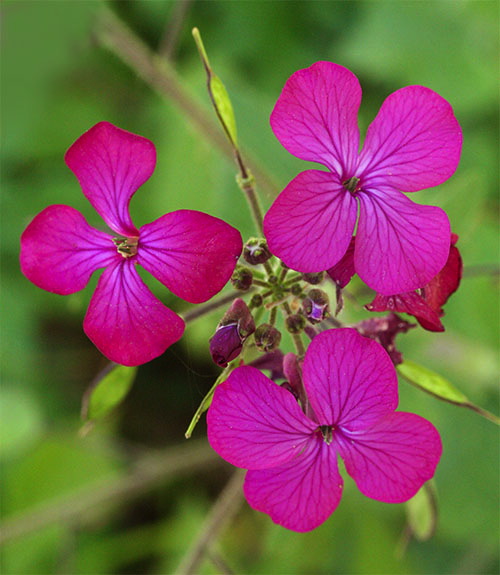
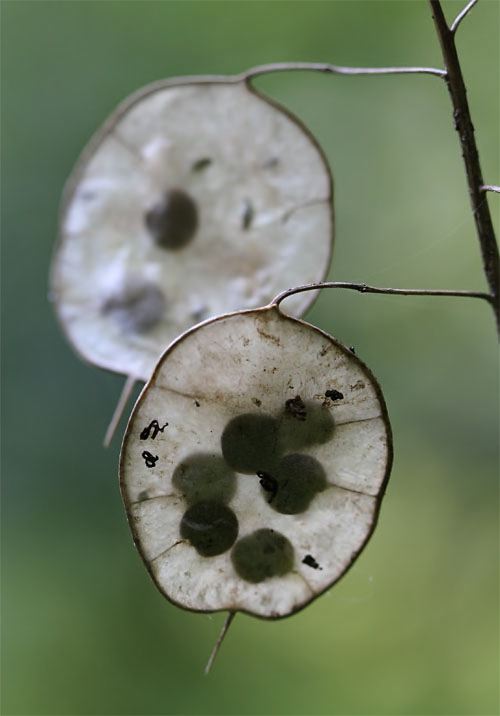 whose common and scientific names are perfectly appropriate, i.e., the pod looks just like a big silver coin--or like a full moon. This biennial species--a member of the Brassicaceae (Mustard or Cabbage Family)--originated in southern Europe and has become naturalized across the Northern Hemisphere, a testimony to the viability of its seeds. Because of its tendency to propagate rapidly in shady spots, we'll keep an eye on this plant; despite the attractiveness of Silver Dollar's four-petalled blossoms, we're inclined to remove its progeny if they become too prolific--lest they crowd out native species that might be less robust.
whose common and scientific names are perfectly appropriate, i.e., the pod looks just like a big silver coin--or like a full moon. This biennial species--a member of the Brassicaceae (Mustard or Cabbage Family)--originated in southern Europe and has become naturalized across the Northern Hemisphere, a testimony to the viability of its seeds. Because of its tendency to propagate rapidly in shady spots, we'll keep an eye on this plant; despite the attractiveness of Silver Dollar's four-petalled blossoms, we're inclined to remove its progeny if they become too prolific--lest they crowd out native species that might be less robust.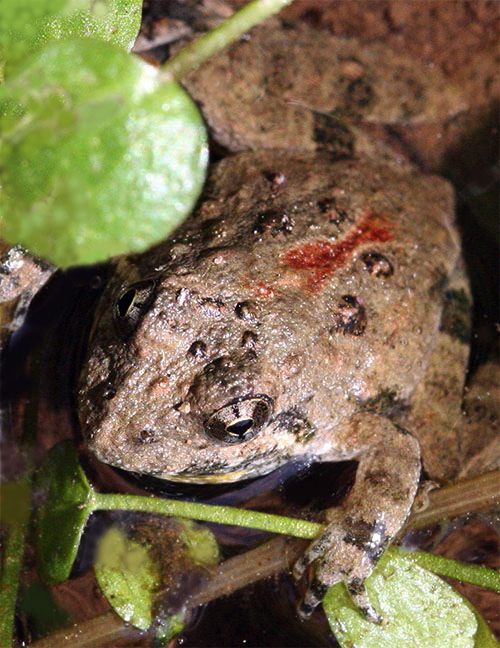
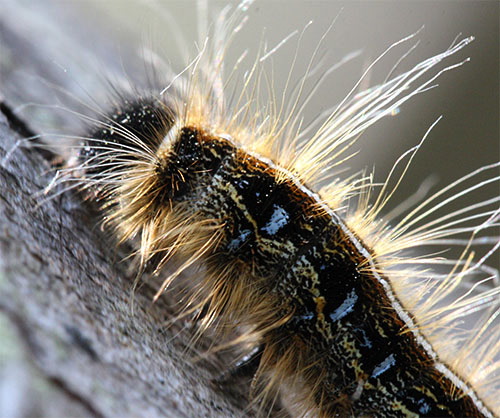
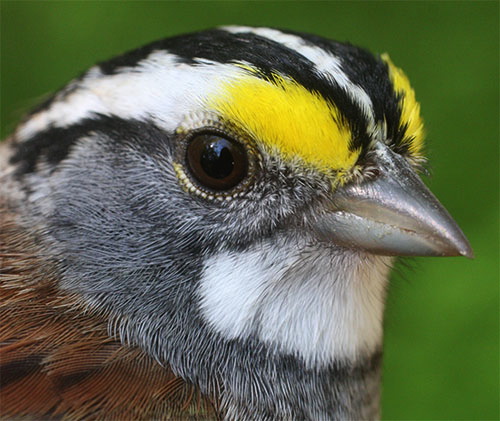
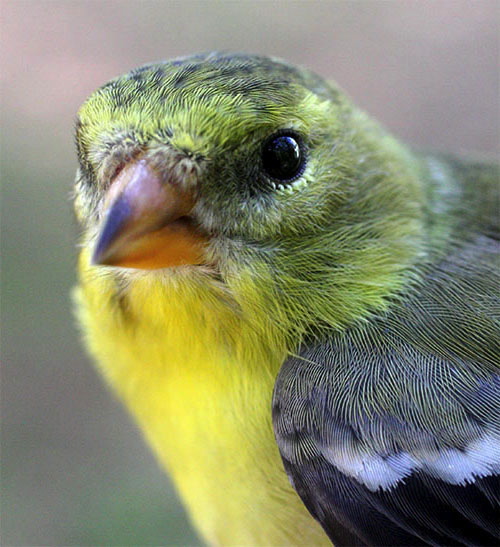
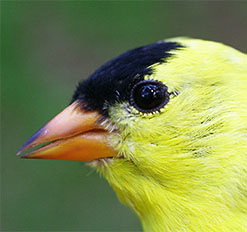 Perhaps less noticeable but nonetheless noteworthy is the color change of the female goldfinch (above). Also drab in winter, she becomes much brighter in April, with a yellower breast and throat and more pronounced facial and head markings. Her wings remain more brownish black than those of the male, but both sexes acquire bright orange bills as winter wanes. We've always been amazed American Goldfinches molt so early in spring because they typically are the last songbirds to breed around Hilton Pond Center. Our earliest fledglings don't appear until August, apparently an adaptation that allows goldfinches to make use of late-blooming thistle seeds they feed their chicks.
Perhaps less noticeable but nonetheless noteworthy is the color change of the female goldfinch (above). Also drab in winter, she becomes much brighter in April, with a yellower breast and throat and more pronounced facial and head markings. Her wings remain more brownish black than those of the male, but both sexes acquire bright orange bills as winter wanes. We've always been amazed American Goldfinches molt so early in spring because they typically are the last songbirds to breed around Hilton Pond Center. Our earliest fledglings don't appear until August, apparently an adaptation that allows goldfinches to make use of late-blooming thistle seeds they feed their chicks.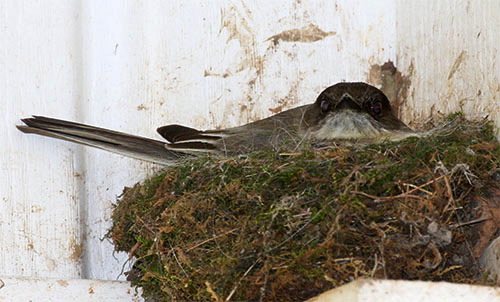


 Please report your
Please report your